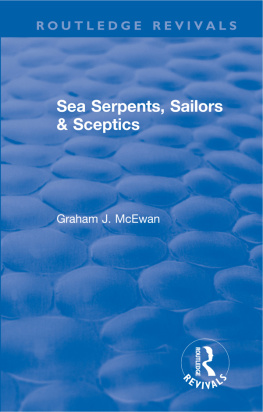Routledge Revivals
Sea Serpents, Sailors & Sceptics
Originally published in 1978 Sea Serpents, Sailors and Sceptics looks at stories of folklore and mythology which have fascinated sailors from antiquity to the modern day. From stories of large unauthenticated sea creatures to the Loch Ness Monster, documented sightings are vast and the book provides a concise survey and review of the subject of ocean folklore. It shows how some large sea creatures, such as the giant squid, have been established and addresses some of the explanations of sea serpents and other sea creatures as now known, categorised species and offers a classification of these species that have formulated the mythologies of the sea throughout time. The book discusses how relatively little is known about the sea still and offers a practical look at the possibility that these mythological creatures, might in fact be, as yet undiscovered species. This book provides a unique interdisciplinary volume, crossing between the area of literature and folklore, and natural historians alike, and will appeal to academics working in the field of natural history and folklore alike.
Sea Serpents, Sailors & Sceptics
by Graham J. McEwan
First published in 1978
by Routledge & Kegan Paul Ltd,
This edition first published in 2018 by Routledge
2 Park Square, Milton Park, Abingdon, Oxon, OX14 4RN
and by Routledge
711 Third Avenue, New York, NY 10017
Routledge is an imprint of the Taylor & Francis Group, an informa business
1978 Graham J. McEwan
All rights reserved. No part of this book may be reprinted or reproduced or utilised in any form or by any electronic, mechanical, or other means, now known or hereafter invented, including photocopying and recording, or in any information storage or retrieval system, without permission in writing from the publishers.
Publishers Note
The publisher has gone to great lengths to ensure the quality of this reprint but points out that some imperfections in the original copies may be apparent.
Disclaimer
The publisher has made every effort to trace copyright holders and welcomes correspondence from those they have been unable to contact.
A Library of Congress record exists under LCCN: 0710089317
ISBN 13: 978-0-367-07728-0 (hbk)
ISBN 13: 978-0-429-02243-2 (ebk)
Sea Serpents, Sailors and Sceptics
Sea Serpents, Sailors and Sceptics
Graham J.McEwan
First published in 1978
by Routledge & Kegan Paul Ltd
39 Store Street
London WC1E7DD,
Broadway House,
Newtown Road,
Henley-on-Thames,
Oxon RG9 1EN and
9 Park Street,
Boston, Mass. 02108, USA
Set in 11/12pt Baskerville by
Express Litho Service (Oxford)
Graham J. McEwan 1978
No part of this book may be reproduced in
any form without permission from the
publisher, except for the quotation of brief
passages in criticism
British Library Cataloguing in Publication Data
McEwan, Graham J
Sea serpents, sailors and sceptics.
1. Sea monsters
I. Title
001.944OL89.2.S478-40159
ISBN 0 7100 8931 7
Plates
Between pages 54 and 55
Figures
I would like to thank the following for permission to reproduce photographs: Mrs M. M. Smith, .
I would also like to thank the following for permission to quote excerpts: Tim Dinsdale and Futura publications, for The Leviathans; the Daily Telegraph; the Orcadian; Cornish Life magazine.
I am grateful for assistance from the following: Tim Dinsdale; David Clarke, editor of Cornish Life magazine; Tony Doc Shiels; Ray Manners of Info magazine; F. W. Holliday; Bob Bird, photographer; The British Museum; Bob Rickard, Editor of Fortean Times; Radcliffe Science Library, Oxford.
ONE
The Case for Sea Serpents
Many creatures whose existence is now firmly established were, a couple of hundred years ago, nothing more than legends and, as the years have passed, various bizarre and improbable creatures have been slowly, often almost grudgingly accepted by the scientific establishment. Many such creatures are marine, one of the most spectacular being the giant squid, which was largely regarded as a mythical beast until the middle of the nineteenth century. This book is based on the six hundred reported sightings of large unknown sea creatures - popularly known as sea serpents - in the past two hundred years. Excluding hoaxes (these being easily identifiable), mistakes, and even merely doubtful sightings we are left with nearly four hundred apparently genuine reports. These reports are trustworthy, not merely because of the obvious good faith and reliability of the witnesses, but because of the consistency of their descriptions, the same details appearing year after year, century after century. Often the creatures were seen by many people simultaneously, such as ships crews and the passengers of liners, all of whose accounts agree on the main features. The time for which the animals were under observation varies from a few minutes up to half an hour, and sometimes longer. The witnesses cannot be accused of being sensation seekers, for many of them kept silent for years about their encounters with sea serpents, fearing, with good reason, that they would be ridiculed. Those who did relate their experiences were, indeed, often treated with scorn.
Even those who have accepted the existence of sea serpents have often confused the issue by maintaining, quite against the evidence, that there is only one type of sea serpent, usually insisting that it is a surviving species of giant reptile from a past epoch. As we shall see, all the evidence points to there being several types of sea serpent, most of which exhibit characteristics which are definitely mammalian. The believers, in fact, have weakened their own case by arguing on a biologically unsound basis.
Most people are unaware of the great number of sightings of sea serpents, as indeed I was before studying the subject. Many accounts appear in old books, small regional newspapers, and defunct natural history journals, and it is unfortunate that the most dubious accounts some blatant hoaxes have often received the widest publicity.
Attempts have been made to dismiss sea serpents as sightings of known phenomena. The inadequacy of such explanations will become obvious to the reader, but it is probably advisable to clear the decks before we start. It has been suggested that the animal seen, and described as a sea serpent, was really a large land snake swimming far from land. Now snakes are good swimmers and some of the larger species are known to make short trips in coastal waters. A 30-foot python would make an impressive spectacle swimming in the sea and its size could easily be exaggerated. However, on land or in water, snakes can move only by















